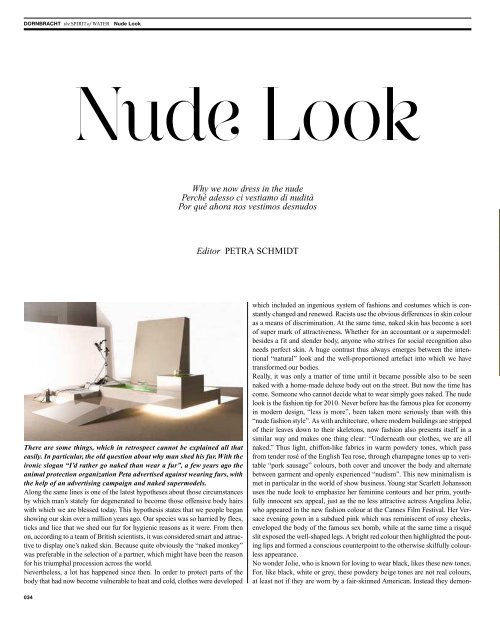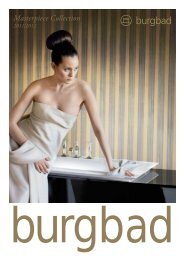productos Dornbracht
productos Dornbracht
productos Dornbracht
Create successful ePaper yourself
Turn your PDF publications into a flip-book with our unique Google optimized e-Paper software.
DORNBRACHT the SPIRITof WATER Nude Look<br />
DORNBRACHT the SPIRITof WATER Nude Look<br />
Nude Look<br />
Why we now dress in the nude<br />
Perché adesso ci vestiamo di nudità<br />
Por qué ahora nos vestimos desnudos<br />
SUPERNOVA<br />
Film stills CHBP (this page)<br />
Photography Thomas Popinger (opposite page)<br />
Editor Petra Schmidt<br />
There are some things, which in retrospect cannot be explained all that<br />
easily. In particular, the old question about why man shed his fur. With the<br />
ironic slogan “I’d rather go naked than wear a fur”, a few years ago the<br />
animal protection organization Peta advertised against wearing furs, with<br />
the help of an advertising campaign and naked supermodels.<br />
Along the same lines is one of the latest hypotheses about those circumstances<br />
by which man’s stately fur degenerated to become those offensive body hairs<br />
with which we are blessed today. This hypothesis states that we people began<br />
showing our skin over a million years ago. Our species was so harried by flees,<br />
ticks and lice that we shed our fur for hygienic reasons as it were. From then<br />
on, according to a team of British scientists, it was considered smart and attractive<br />
to display one’s naked skin. Because quite obviously the “naked monkey”<br />
was preferable in the selection of a partner, which might have been the reason<br />
for his triumphal procession across the world.<br />
Nevertheless, a lot has happened since then. In order to protect parts of the<br />
body that had now become vulnerable to heat and cold, clothes were developed<br />
which included an ingenious system of fashions and costumes which is constantly<br />
changed and renewed. Racists use the obvious differences in skin colour<br />
as a means of discrimination. At the same time, naked skin has become a sort<br />
of super mark of attractiveness. Whether for an accountant or a supermodel:<br />
besides a fit and slender body, anyone who strives for social recognition also<br />
needs perfect skin. A huge contrast thus always emerges between the intentional<br />
“natural” look and the well-proportioned artefact into which we have<br />
transformed our bodies.<br />
Really, it was only a matter of time until it became possible also to be seen<br />
naked with a home-made deluxe body out on the street. But now the time has<br />
come. Someone who cannot decide what to wear simply goes naked. The nude<br />
look is the fashion tip for 2010. Never before has the famous plea for economy<br />
in modern design, “less is more”, been taken more seriously than with this<br />
“nude fashion style”. As with architecture, where modern buildings are stripped<br />
of their leaves down to their skeletons, now fashion also presents itself in a<br />
similar way and makes one thing clear: “Underneath our clothes, we are all<br />
naked.” Thus light, chiffon-like fabrics in warm powdery tones, which pass<br />
from tender rosé of the English Tea rose, through champagne tones up to veritable<br />
“pork sausage” colours, both cover and uncover the body and alternate<br />
between garment and openly experienced “nudism”. This new minimalism is<br />
met in particular in the world of show business. Young star Scarlett Johansson<br />
uses the nude look to emphasize her feminine contours and her prim, youthfully<br />
innocent sex appeal, just as the no less attractive actress Angelina Jolie,<br />
who appeared in the new fashion colour at the Cannes Film Festival. Her Versace<br />
evening gown in a subdued pink which was reminiscent of rosy cheeks,<br />
enveloped the body of the famous sex bomb, while at the same time a risqué<br />
slit exposed the well-shaped legs. A bright red colour then highlighted the pouting<br />
lips and formed a conscious counterpoint to the otherwise skilfully colourless<br />
appearance.<br />
No wonder Jolie, who is known for loving to wear black, likes these new tones.<br />
For, like black, white or grey, these powdery beige tones are not real colours,<br />
at least not if they are worn by a fair-skinned American. Instead they demonstrate<br />
the absence of colour, because both dress and its wearer near each other<br />
in colour. What emerges is a skilful interplay between uncovering and covering,<br />
physicality and disembodiment. An interplay, which British actress, Tilda<br />
Swinton, knows all about. The actress, who happily presents herself as androgynous<br />
with her masculine haircuts, consciously produces the dissolving of<br />
inherent forms in a drape of flowing skin-coloured fabrics. She styles herself<br />
to become a fashion icon, by seeming to display at the same time both body<br />
and dress. With this unusual appearance the diva appears as an inaccessible art<br />
being – as an incredible fable figure like the ones we also know from her films.<br />
However, despite all of this modern minimalism, examples of a similar stylish<br />
daring can also be found by looking at history. At the forefront are the chemise<br />
dresses, which emerged around 1800 and which were likewise called “naked<br />
fashion”. Fashion-conscious ladies in the Napoleonic era wore wafer-thin cotton<br />
dresses that were gathered under the bust over skin-coloured underclothes.<br />
At that time the mock nudity dispersed of course not only admiration, but also<br />
outrage and open refusal. But the envious remarks had little effect on fashionconscious<br />
ladies such as Joséphine, wife of Napoleon, and the famous socialite,<br />
Juliette Recamier. Even in cold weather they wore the airy dresses, which were<br />
mostly made of wafer-thin cotton muslin or cambric, and besides common<br />
colds sometimes also caught dangerous pneumonia, afflictions which were<br />
quickly consolidated under the expressive term “muslin illness”. But neither<br />
illness nor scandal could deter the ladies, most of whom were very young, from<br />
the latest fashion. This fashionable form of liberation was clearly very important<br />
to them.<br />
The American sociologist Richard Sennett, who came to fame with his pessimistic<br />
commentary about modernity, naturally views this in a more critical<br />
light. In his theory on the tyranny of intimacy he reaches the conclusion that<br />
before 1750 the general public would have resembled a stage, on which each<br />
protagonist understood how to disguise himself according to status and rank.<br />
The people of that time played parts such as master and servant, according to<br />
his opinion, and would always have been conscious of this staging. But then the<br />
game got serious. The decorative symbols and masks became standardized and<br />
thus freely available. Today, everybody uses this reservoir of symbols for a<br />
personal staging which would be keenly studied and interpreted by his environment.<br />
Every tattoo and every accessory would be considered not merely a<br />
symbol, but a “truthful” expression of the individual. “The more uniform images<br />
of the body became, the more seriously they were taken by people as an<br />
indication of the personality,” Sennett believes.<br />
Italian-born performance artist, Vanessa Beecroft, knows just how seriously.<br />
Ensuing from her own eating disorders, she dedicates her performances to the<br />
prevalent body images. Her performances involving mostly naked women are<br />
reminiscent only at first glance of fashion shoots or catwalk shows. With her<br />
Tableaux Vivants of naked women who are dressed merely with transparent<br />
tights or long boots, rather she takes up the themes of self-destruction, eroticism,<br />
fashion mania and the limitless desire for affirmation and admiration.<br />
She describes her stagings as “minimalist sculptures”, with which not only her<br />
performers undress, but also the spectators. Not because they would have to get<br />
undressed, but because they always become a part of the performed piece, and<br />
must feel unavoidably like a voyeur.<br />
And this is the dilemma with open nakedness. Although we secretly regard<br />
them with interest, we nevertheless feel extremely uneasy in the presence of all<br />
those naked people. But because even the nude look will remain only a short<br />
fashion fad, we should not allow to spoil the fun. It is after all only a game of<br />
“emperor’s new clothes”. And if there was one thing Immanuel Kant knew: “It<br />
is always better, nevertheless, to be a fool in fashion than a fool out of fashion.”<br />
Ci sono cose che poi non si possono più spiegare così facilmente. In particolare<br />
se si tratta della storica domanda sul perché l’uomo ha perso la pelliccia.<br />
Alcuni anni fa, l’organizzazione di protezione degli animali Peta<br />
protestava contro le pellicce con lo slogan ironico “meglio nude che in pelliccia”<br />
e con l’ausilio di una campagna pubblicitaria e di supermodelle<br />
nude.<br />
034<br />
035
















